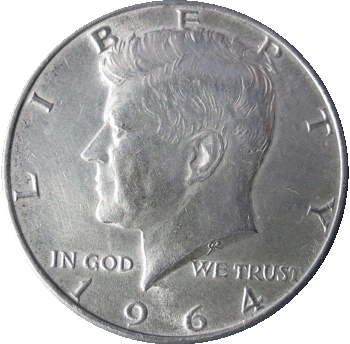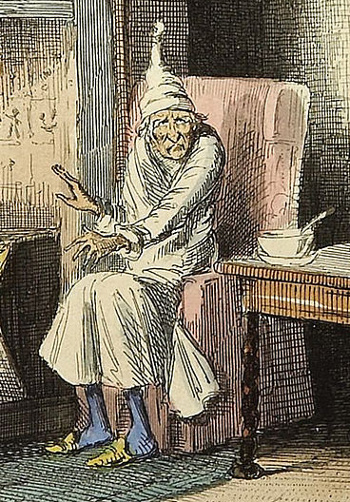Making Change
July 19, 2013
As a student of
solid state physics, I was introduced to the many ways that
quantum mechanics has been applied to
solids. The isolated
hydrogen atom is typically presented as the
model system for quantum mechanics, since its
energy levels are relatively easy to
calculate, and they agree marvelously with
experimental spectral measurements.
When you combine hydrogen atoms into something that actually exists in nature,
hydrogen molecules (H
2), things get a little harder. When you combine many
atoms of different types into a solid, it's nearly time to put away the
books and take up
gardening.
Fortunately, most solids are not a jumbled mass of atoms or
molecules, they're
crystals in which the atoms are arranged in
spatial order. This gives the
theorist another way to do his quantum calculations; and, in the first few
decades after
World War II, the quantum theory of crystals was developed to the point where the performance of
semiconductor devices could be predicted and improved.
Hans Bethe was ahead of the curve with his 1929 article, Termaufspaltung in Kristallen (Splitting of Terms in Crystals), which appeared in the
Annalen der Physik.[1]
Electrical conductance in
semiconductors, such as the
silicon that comprises most
transistors, is explained by
electronic band theory in which
electrons can exist in certain states, but not others. One such band is the
valence band of states that glues the crystal together, and these electrons are too busy doing this to do anything else.
Higher in energy are the conduction electrons with energy states so dense that they form a
conduction energy band. In a semiconductor, there's a forbidden range of energies between the valence and conduction bands, and electrons need an energy boost greater than this
gap to be promoted from the valence band to the conduction band. That's why the electrical conductivity of semiconductors increases with
temperature, since thermal forces are putting more electrons into a conduction role.
At the time I learned all this,
sales taxes were just becoming popular (or notorious) as a means of generating
government income. I realized that there was an
analogy between item prices with sales tax and forbidden energy levels, as follows. Before sales tax, I could buy an item for 99 cents ($0.99). According to the sales tax rule at the time, I needed to pay $1.00 for that item; that is, 99 cents had become a forbidden price. It was impossible to buy something for ninety-nine cents.
This leads to another interesting problem. If it were possible to pay 99 cents for an item, how many different ways could you do this? Using common
US coinage in which
fifty cent pieces are now rare, the method using the least number of coins would be three
quarters, two
dimes, and four
pennies, for a total of nine coins. The least efficient way, of course, is 99 pennies. In between, there's a wide spectrum of possible coins.
Computationally, you could enumerate the number of ways by starting with the coin set {25,25,25,10,10,1,1,1,1}, then breaking down each member individually into smaller coins; thus, the next coin set would be {10,10,5,25,25,10,10,1,1,1,1}, etc. Since this is a simple enough
computer program, I tackled it with the
attached source code in my
casual coding style.
It would be just as easy to
enumerate these by hand, since it's a simple
tree. There are 31 possible coin combinations to render $0.99. Here are a few of the smallest. We first split the 25-cent pieces into dimes and nickels, then the dimes into
nickels, and the nickels into pennies.
{25,25,25,10,10,1,1,1,1}
{10,10,5,25,25,10,10,1,1,1,1}
{10,10,5,10,10,5,25,10,10,1,1,1,1}
{10,10,5,10,10,5,10,10,5,10,10,1,1,1,1}
{5,5,10,5,10,10,5,10,10,5,10,10,1,1,1,1}
{5,5,5,5,5,10,10,5,10,10,5,10,10,1,1,1,1}
{5,5,5,5,5,5,5,10,5,10,10,5,10,10,1,1,1,1}
{5,5,5,5,5,5,5,5,5,5,10,10,5,10,10,1,1,1,1}
{5,5,5,5,5,5,5,5,5,5,5,5,10,5,10,10,1,1,1,1}
{5,5,5,5,5,5,5,5,5,5,5,5,5,5,5,10,10,1,1,1,1}
{5,5,5,5,5,5,5,5,5,5,5,5,5,5,5,5,5,10,1,1,1,1}
{5,5,5,5,5,5,5,5,5,5,5,5,5,5,5,5,5,5,5,1,1,1,1}
...etc., for 31 total combinations.
In the cold weather months, I'll usually have change for any fractional part of a dollar, since my
coats have large
pockets in which I carry a lot of coins. In that case, I'm just like an
athlete who wears
training weights. I've never examined the
distribution of coins in my coin stash, but I'm sure that it would follow some
statistical rule.
Two
mathematicians have posted a
paper on
arXiv to answer the question "What set of coins is most likely to be the contents of your wallet?" They are
Lara Pudwell of the
Department of Mathematics and Computer Science,
Valparaiso University (Valparaiso, Indiana) and
Eric Rowland of the
Laboratoire de combinatoire et d'informatique mathématique,
Université du Québec à Montréal (Montreal, Canada).[2-3]
Their calculation was a little more involved than my simple program, since they looked at all ways that fractional parts of a dollar that can be returned as change from a purchase, not just the ninety-nine cent case. Their assumptions were that there's a
uniform distribution of prices between 0 and 99 cents and
cashiers return change as the smallest number of coins. As in my example, half-dollar coins were disallowed.

John F. Kennedy half-dollar coin in its first year of issue, 1964.
The 1964 coin actually contained 90% silver.
Half dollar coins are rarely circulated, although inflation makes dollar coins a more likely option in the future than in the past.
(Photograph by Dritto, via Wikimedia Commons.)
If you spend no coins, but just collect coins from all transactions under a dollar, you should have 150 quarters, 80 dimes, 40 nickels, and 200 pennies in the end. Percentage-wise, this is 31.9% quarters, 17.0% dimes, 8.5% nickels, and 42.6% pennies.[2] That calculation is also easy to do, but I've left it as an
exercise for the reader, which is what my
professors and
textbook authors always said.
When I was a
child, I could purchase "
penny candy." Now, a penny wouldn't even buy you the right to sniff a
chocolate bar, since inflation has rendered pennies practically worthless. In 1982, when the
copper value of a
US penny was nearly a penny, the
US Mint started making pennies which are 97.5%
zinc with a 2.5% copper
plating. Still, the manufacturing and distribution cost of a US penny is about two cents.[4]
People don't usually carry pennies, and they drop them into the popular give-a-penny/take-a-penny cups at cashiers. So, these shoppers are "pennyless," as distinct from "
penniless," and they require a different
analysis. The following table shows the ten most likely wallet states for the pennyless purchaser. Note that even the most
probable state, that of an empty wallet, has just a five percent likelihood.
| State | Probability | | State | Probability |
| {empty} | .05000 | | {10, 5, 5} | .02731 |
| {5} | .05000 | | {25, 25, 10, 5} | .02625 |
| {10, 5} | .03916 | | {5, 5} | .02536 |
| {25, 10, 5} | .03093 | | {10} | .02463 |
| {25, 5} | .02847 | | {25, 10, 5, 5} | .02417 |
For those of us who aren't pennyless, the following statistics apply to our wallets, assuming that we carry less than a dollar in coins.[2]
• There should be ten coins.
• The probability that there is at least one nickel is 0.58085.
• The probability that there is at least one penny is 0.95975.
• The probability of there being only pennies, if you have any coins at all, is 0.08430.
• The probability of having an empty wallet is .01000.
• The probability of having the exact change is only 0.00831.
• The expected number of quarters is 1.06.
• The expected number of dimes is 1.15.
• The expected number of nickels is 0.91.
• The expected number of pennies is 6.92.
My cold weather pockets contain enough in coins that I always have exact change. I suspect that keeping about two dollars in coins, perhaps
weighted on the penny side (in more ways than one), is enough to ensure that fact.
Pudwell and Rowland also calculate the approximate distribution of
circulating coins as 10.5% quarters, 11.5% dimes, 9.1% nickels, and 68.9% pennies. The distribution of U.S. minted coins in 2012 is actually 6.1% quarters, 18.1% dimes, 11.0% nickels, and 64.8% pennies.[2] Not bad for an
ab initio calculation.
The statistics might be skewed, slightly, by people who
hoard certain coin denominations. My
uncle Walt, for one reason or another, had a giant jar of pennies in his room. I think he was hoping to collect something of
numismatic rarity.
Evelyn Lamb admits to being a quarter-hoarder in her
Scientific American blog.[3] Her reason is their utility in coin-operated
laundry machines. I do the same, for
road tolls, which are generally collected by
automated machines in our area. I don't use
E-ZPass, since I'm a "
privacy nut."

This would be a perfect place for an image of Disney's Scrooge McDuck diving into his money bin of gold coins; but, alas, the present idea of perpetual copyright has rendered many such things impossible.
Instead, we must be satisfied with this 1843 John Leech (1817-1864) drawing of Ebenezer Scrooge from Dickens' A Christmas Carol
In 2007, Forbes estimated McDuck's fortune as $28.8 billion, or about half Bill Gates' net worth.[5]
(via Wikimedia Commons.)
![]()
References:
- H. Bethe, "Termaufspaltung in Kristallen," Annalen der Physik, vol. 395, no. 2 (1929), pp. 133-208. Translation appears in Splitting of Terms in Crystals, chap. 1 of Selected Works of Hans A. Bethe: With Commentary, (World Scientific, Jan 1, 1997), 605 pages.
- Lara Pudwell and Eric Rowland, "What's in your wallet?!" arXiv Preprint Server, June 9, 2013.
- Evelyn Lamb, "Mathematicians Predict What's in Your Wallet," Scientific American Blogs, June 20, 2013.
- Michael Zielinski, "Cost to Make Penny and Nickel Declines But Still Double Face Value," Coin Update, December 10, 2012.
- Bill Gates, The World's Billionaires (#2), Forbes, March, 2013.
Permanent Link to this article
Linked Keywords: Solid-state physics; quantum mechanics; solid; hydrogen atom; mathematical model; model system; energy level; calculation; calculate; experiment; experimental; spectroscopy; spectral measurement; hydrogen molecule; atom; book; gardening; molecule; crystal; crystal structure; spatial order; theory; theorist; decade; World War II; semiconductor device; Hans Bethe; Annalen der Physik; electrical conductance; semiconductor; silicon; transistor; electronic band structure; electronic band theory; electron; valence band of states; conduction energy band; band gap; temperature; sales taxes in the United States; government; analogy; coins of the United States dollar; US coinage; half dollar (United States coin); fifty cent piece; quarter (United States coin); dime (United States coin); penny (United States coin); computer program; coins.c; source code; hacker programmer subculture; casual coding style; enumeration; enumerate; tree; nickel (United States coin); coat; pocket; sportsperson; athlete; weight training; training weight; probability distribution; statistics; statistical; mathematician; scientific literature; paper; arXiv; Lara Pudwell; Department of Mathematics and Computer Science; Valparaiso University (Valparaiso, Indiana); Eric Rowland; Laboratoire de combinatoire et d'informatique mathématique; Université du Québec à Montréal (Montreal, Canada); uniform distribution; cashier; John F. Kennedy; half-dollar coin; silver; inflation; dollar coin; Wikimedia Commons; exercise; professor; textbook; author; child; bulk confectionery; penny candy; chocolate bar; copper; US penny; United States Mint; US Mint; zinc; plating; penniless; analysis; probability; weighting; weighted; circulation of currency; circulating; ab initio; hoarding; hoard; uncle; numismatic; Evelyn Lamb; Scientific American; blog; laundry machine; toll road; road toll; automation; automated machine; E-ZPass; privacy concerns; The Walt Disney Company; Disney; Scrooge McDuck; perpetual copyright; John Leech (1817-1864); Ebenezer Scrooge; Charles Dickens; A Christmas Carol; Bill Gates.